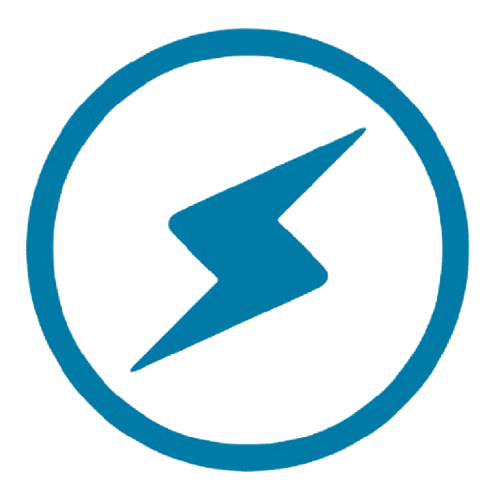I wanna talk about a killer document strategy. So how do you create documents that drive conversions that are high authority, that is worthwhile, that make us look good, and make us operate more efficiently? And I’m not saying we need to be a lawyer– generate lots of documents cuz that’s kind of what they do for the sake of it.
I’m not saying like in school where we generate a paper where it’s got to be at least 20 pages of X number of words and 12 point font. I’m talking about creating winning documents.
And I want to show you frameworks that I think you’ll find eye-opening, simple yet complex, and doable, as it doesn’t require having an army of people. This will work if you have a huge company and this will work if it’s just you doing some freelance side job.
Cause I find that what differentiates a lot of entrepreneurs is their ability to communicate and communicating through documents is something that other people just don’t seem to have.
1. Design Guide
You have to have documents that show what you do so people are clear because when people are unclear, it’s hard for them to buy from you. It’s hard to onboard customers and it’s hard to train people. And so we created this thing that we call the design guide. And on the surface, the idea of a design guide is anytime we produce a document, the design guide will show the fonts, colors, and logos a.k.a. Brand Style Guidelines.
Because if you’re gonna hire a virtual assistant, you don’t wanna have to train them on everything every time. You want to be able to give them a brand guidelines document that consists of where they can find the assets that they will be needing– such as where to download your logo or an example of how you create your presentations and how you turn them into courses and what you do when you take a webinar and turn that into a course.
How do we do this in a way that helps us win as entrepreneurs so that we don’t get sucked into the nitty gritty so that any content that we produce is gonna be reusable across any other format. Design is deeper than just fonts, logos, and colors. When the design is done properly, It communicates the message.
So how do we go deeper? So we start with things like the logo and a lot of people where they start with the logo, they go to fiver, which is great. You can get a $20 logo on fiver, but how do you have this embody what you stand for? So here is our logo for example,

We want other people’s light bulbs to go off. And the idea of Coach Yu is a play on words, I’m coaching you aside from the fact that it’s also my name. And so when we use this everywhere and we use these colors, especially blue, like the light blue, which is for business, then people will see it differently than if they see it with a lot of orange or pink or colors, which are not a primary color, which is seen as more of like entertainment colors.
So color palettes are also very important as they need to fit together to the overall concept. So if you’ve chosen a primary color palette, then that’s going to fit into all the other related colors that you will tie with it. And there is the color wheel. There are lots of tools that will help you choose different colors including the hex code for getting that color. If you’re not a designer, you don’t need to know any of this kind of stuff, but it’s just neat to know that colors convey meaning. That’s why people spend so much effort on the Nike symbol.
You wanna make sure that anyone who’s working on your stuff has access to these components. And a lot of people will think, well, that should be part of my media kit and it should be consistent across my website and social media and my branding documents and brochures and business cards.
So you want to have a guide that has these things because then anyone who’s on your team has a handy reference. Anytime the media wants to reference you, anytime you’re on a podcast, you can send this out and it’ll be consistent.
And we think that it’s critical to have a document like this and goes through this, like even listing what is the font that we use so that way it can be similar every single time.
2. Templates
When we put together things like courses and presentations, the first page is a cover page and the cover page can be landscape like the left below, a PowerPoint-ish presentation or it can be vertical (right side image below), which is what we think of as more like a book.
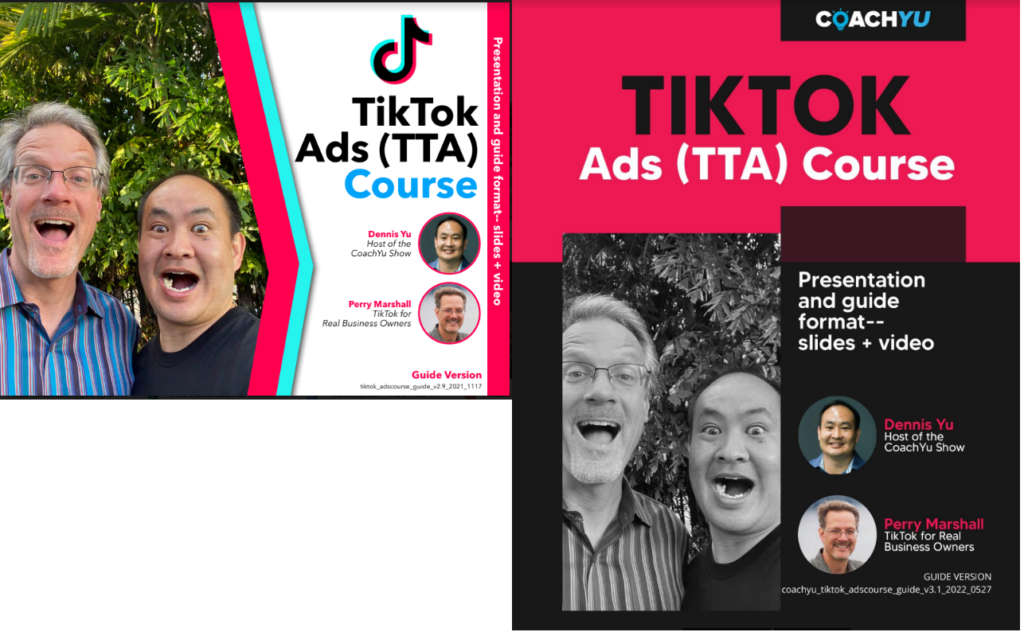
And the thing that makes these things look nice is not because there’s a great designer who has to invent something new every time. It’s that there’s a template, but the template isn’t completely non-thinking.
3. Checklists
While you have your Design Guide and templates in place, you have to make sure that those are governed by checklists so that you don’t have to reinvent the wheel every single time you wanna produce a new document so you have consistency, not because you want everything to look cookie cutter the same, but because you wanna make sure it has all the components that actually work.
For example, here, we have this badge.

So we know that everything that we put out there with this badge is a course. People should be able to go through it like a recipe. And once they do it, they should be able to earn the badge by following the checklist step by step.
But if we don’t have a badge, then either the designer didn’t put the badge there, or we didn’t turn the course into a checklist, which then people can follow and actually assess whether they do all the things or something else got dropped along the way.
So when you have a checklist for all the items that you need in your documents, then you know that the rest of these things are functioning and can operate without you having to be there watching every link and piece. And if someone didn’t do their part, someone else can step in and take over it.
4. Master Document
So we have something that we call the master guide and the master presentation. And the idea of the “master” is that it is the ring that rules all rings.
And so we can reuse this in so many different ways and it looks great. Can you imagine if you had to build a presentation from scratch every single time, how much effort it would be? Have you ever been in that situation where you have to give a presentation on something tomorrow and you waited till the last minute? You had three or four weeks to put it together, but you waited till the last minute, now you have to stay up all night, putting together some presentation and you’re already tired, it’s midnight, but you have to stay up and you’re thinking, man, I can spend an extra hour or two and put together this presentation, but then I’m gonna be tired tomorrow or should I just kind of cut it short and kind of go with what I have and get more sleep, but not have the best presentation materials.
Now you don’t have to because when you have a template and everything’s already in place, then you can just pick and choose from the master presentation, reskin it, change up a couple of different items, and all of a sudden you have a new document. And it’s not like anyone else has seen all the rest of your other documents.
For example,
So you can see how all this stuff is reusable. So the master presentation is our granddaddy of all slides. And so a presentation is meant to be a presentation just like right now. And the beauty of a presentation is it’s not word-heavy because in a presentation, you’re speaking the words. So the words aren’t on the page. So the guide version is where people can read the thing. So the guide is vertical. It’s like a book. If it’s meant for people to read.
So presentations, images, videos, not much text because someone’s presenting. A guide is set up like a book. No one’s presenting it. They’re reading the words themselves so it’s lots of words. So we have a master presentation and a master guide. The beauty of these two being linked together is that when you give a presentation, you can then transcribe it and run it through Descript– our whole book editing process.
It’s better to have the guide version first, and then you can give a presentation from the guide, but sometimes our designers or our people are just not ready or prepared, or we’re still scrambling to get some stuff going. So we just give the presentation and then make the guide afterward based on the zoom recording. Not the ideal way to do it, but it’s a fail, safe, graceful failure way of doing things.
5. Asset Tracker
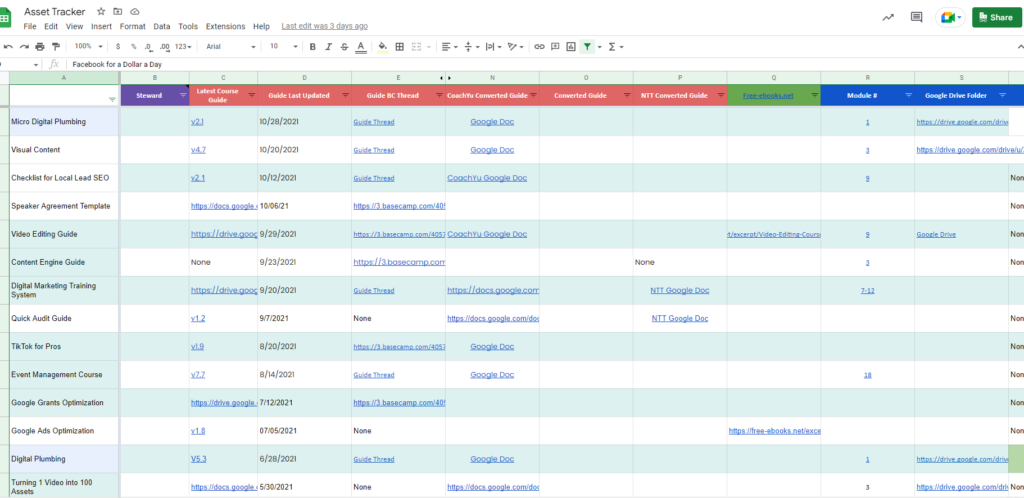
So for each piece– guides, courses, webpages, we have the latest link indicated in this tracker. We have the date on when it last iterated. We have a presentation version. We may have an implementation version and related sorts of pieces.
So this is a little bit complex, cuz we’re talking about sophisticated document management but is actually pretty simple.
6. One-Pagers
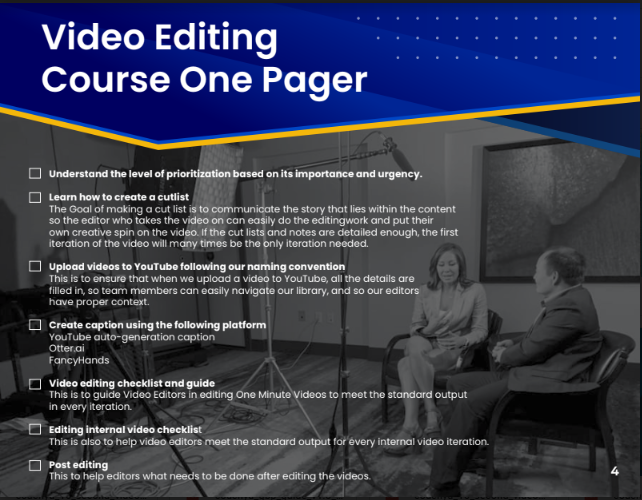
So we have different versions of the same content, which is all part of this checklist architecture, because it’s the same checklist, whether it’s a guide or a presentation or us as an agency implementing it, it’s still the same checklist, just different formats of the same thing. You know, it’s like a mountain bike that can be painted blue or green or purple.
You can put racing tires on it or whatever tires but it’s still a bike. It’s just different versions of the same thing.
The one-pager is a list of these particular tasks. So the idea of this checklist architecture is anything that is repeatable should have its own one-pager. It’s the process in checklist form– it’s written down where you have documented exactly how to do each of these particular components so the business should be able to operate without you because someone should be able to go through that training on how to do whatever it is.
So one component inside a checklist is one page and a one-pager is a way to be able to quickly tell if that task is done. So think about a list of tasks, the task that could be set up. Digital plumbing could be boosted. Like whether you’re your business is putting people’s faces on socks or, you know, fixing their teeth or helping them buy a house, you’re still gonna have the stages of making sure things are happening– that you’re providing the service. You’re following with the customer, you’re collecting the money, you’re hiring people. So when you have a one-pager to see if something is happening and to make it happen, each of these tasks has to be smart, specific, measurable, attainable, realistic and time-bound. That way you can actually determine whether the thing happened or not. Each of the tasks that we have has a superscript and that super script ties back to what we call the thousand task library.
7. 1000 Task Library
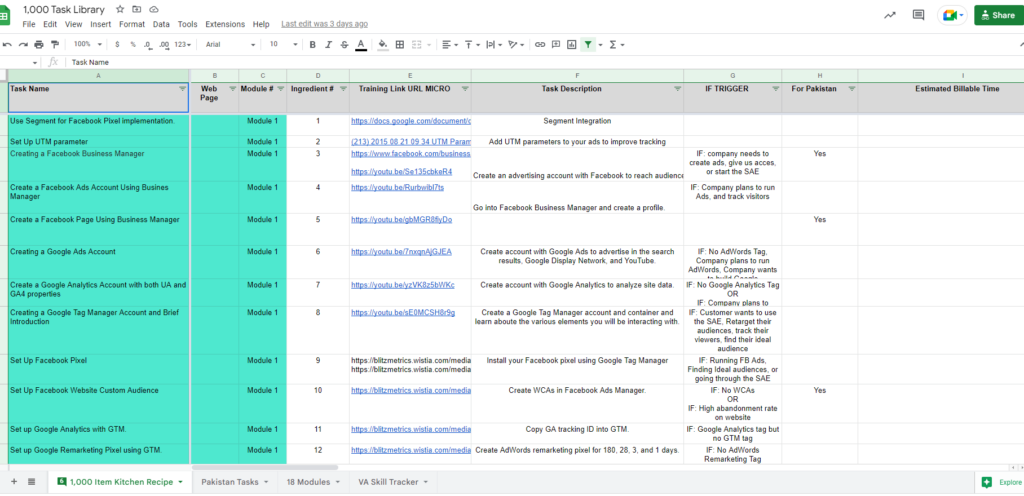
Because we have more than a thousand tasks in our library, any of these tasks goes back to the Asset Tracker sheet where you can see the video associated with it, here’s how to audit it, to make sure it’s being done the way we want it. Any checklist is composed of tasks of which individual building blocks we can audit if they’re being done.
And if it’s not being done, we can figure out, did the person not follow directions, was the training not clear enough on how to do that task, or maybe that task is so big, it should be broken into multiple tasks or it needs to be reordered in another way. So that way any execution we have, we can easily audit.
And then it’s not a subjective matter of whether we think that’s a beautiful painting or not, it’s not subjective. The beauty of a checklist it can tell you directly if a task is done or it’s not.
8. Social Amplification Engine

We can see for those of us who have a business, what’s already working and driving sales. We can figure out what we can troubleshoot, what component we need to fix, and what are some limiting components. And when we have this stuff set up in the right way, it’s easy for us to see.
So consider this the heart of marketing and training and operations because if you don’t document what you do, it’s not repeatable.
And then anytime someone has a question on that thing, then you have to personally, one on one coach them privately how to do something, which is great for them, because then they get your personal touch, you’re available, it shows that you care, but it also makes it impossible for you to scale because there’s no documentation to fall back on.
And the reason we create documentation is not that we’re inhuman and we just want people to read the documents or to Google, it so that we can spend quality time with people instead of repeating things that we’ve already said before. You want your time to be quality. So the whole thing with having these documents is to free us up to do what we as humans should be doing, which is building relationships. And so when we have VAs that are working on this kind of training on how to do stuff, we make sure that we’re doing the task with an eye towards recording it so that it’s repeatable.
You should always think about that too because we only have so much time on this planet and we wanna think about maximizing it. So we don’t have to do the same thing over and over again. How many times do you find yourself repeating the same thing or doing the same task or something that you know is repeatable?
And the answer is usually two to three hours every day. That’s a lot of time that adds up. If we just create these documents, turn these documents into videos, and add them into a learning management system–like Learndash, InfusionSoft, Click funnels, Kajabi, and another tool that we are working with right now.
So when we’re organizing our content, we think of these levels of content:
1. Public content is free, it’s like blog posts.
2. Gated content is still free it’s just that they have to give us their email address. They have to opt-in. They have to fill a lead for them to get it but still, it’s free.
3. Trip Wire Content-where they pay like a trip wire–seven bucks, 10 bucks, or Office Hours as like our program here. We think of this as a trip wire because we don’t make any money on it. We actually lose money on this program. If you think about how much effort and the cost to do everything.
You go from why, and how to what. This is how people are gonna sign up. You can see that when you organize content the right way, it’s automatically built to be public, gated free or not free, and then into your product or service. So this works for any product or service. It can be for the real estate agents, you can be a mortgage broker, it’s still the same thing, cuz you still need to be known. You still need to share your expertise.
This whole system of documentation assumes that we have some kind of competency that is worth documenting. It’s based on our direct experience.
So we have talked about Fiverr a lot, and I know it’s a lot of freelancers but the hesitation with Fiverr is finding the right person.
Cause there are a number of times when you think the right person wasn’t found and that leaves a bad taste in your mouth. So my question to you is how are you conducting your screening process? How do you define your requirements?
So in your screening process, you should share your requirements, you get their explicit acknowledgment that they can do it. You have to negotiate with them and get clear on your requirements before you ever press the buy button. And that’s why you have to document what you’ve done. That way, when you wanna have that fiver person go do it, they have something to reference. If you don’t have anything to reference, let me tell you the cold hard truth, the issue is not the Fiverr person. The issue is you weren’t clear about what you wanted.
So it’s providing more clarity because If you just say to someone on Fiverr, “Can you edit a video and make it really nice?” And they’ll say, “Oh, how many minutes is it?” And you’ll say, “Oh, 10 minutes” And then they give you something that isn’t in your style, that isn’t the way you want it and that is why it is very important that you have to say “have it in this style”, “here’s the template”, “here’s the process”, “here are examples of how I’ve done it before”, “here’s three other examples of how I’ve seen it done before and the way I like it.”, “here are the files that I need to be edited, take a look at them and give me a quote, and don’t just give me a quote, show me in your response that you understand specifically what I’m looking for and have examples where you have done work like that before”. Then at that point, it’s very easy. You know, it’s gonna be successful when you hired them.
This episode is one of many live and pre-recorded trainings in the Office Hours program, which Office Hours members have full access to.
